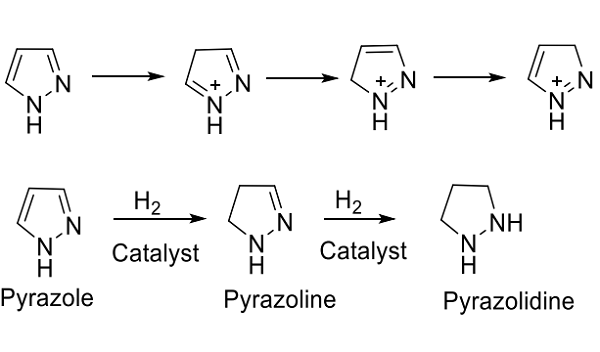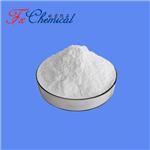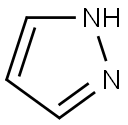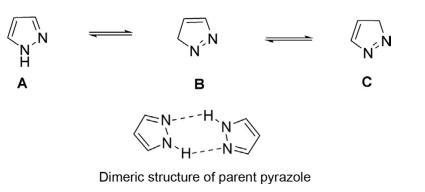Pyrazole: Chemical property and Pyrazole analogs
Introduction
Pyrazole is any of a class of organic compounds of the heterocyclic series characterized by a ring structure composed of three carbon atoms and two nitrogen atoms in adjacent positions. The simplest member of the pyrazole family is itself, a compound with molecular formula C3H4N2.
Chemical property
Pyrazole is a π-excess aromatic heterocycle. Electrophilic substitution reactions occur preferentially at position 4, and nucleophilic attacks at positions 3 and 5. The pyrazoles diversely substituted by aromatic and heteroaromatic groups possess numerous biological activities, which makes them particularly interesting. With a melting point of 70°C, Pyrazole is a colourless solid. This high value is due to intermolecular hydrogen bonding, resulting in a dimmer (compared with 1-alkyl or aryl-substituted pyrazoles). Pyrazole is a tautomeric substance: in Pyrazole itself, the presence of tautomerism cannot be shown but can be inferred by considering pyrazole derivatives. Pyrazole exhibits aromatic properties, e.g., readily halogenated, nitrated and sulphonated; the group enters at position 4. The following resonating structures are possible for Pyrazole. Pyrazole has a weak base and forms salts with inorganic acids; it is possible to substitute imino hydrogen with an acyl group. Pyrazole is highly resistant to oxidizing and reducing agents but can be catalytically hydrogenated, first with pyrazoline and then with pyrazolidine. However, stronger bases than Pyrazole are among these compounds.

Two nitrogen atoms are in a five-membered ring in the aromatic organic heterocycle containing pyrazole scaffolds. Pyrazole derivatives are essential in the family of aromatic organic heterocycles. Numerous uses for fluorescent agents, dyes, agrochemicals, and more have been found in pyrazole derivatives. Pyrazole is a multipurpose lead compound for efficient biologically active T-molecules formed by chemical architecture. They have shown widespread biological and pharmacological activity such as antitumor, antiinflammatory, antimicrobial, antidepressant, antifungal, antimalarial, enzyme inhibitors, antidiabetic, and anticonvulsant.
Pyrazole analogs
Pyrazoles are five-membered heterocycles that constitute a class of compounds particularly useful in organic synthesis. They are one of the most studied compounds among the azole family. Indeed, many synthesis methods and synthetic analogues have been reported over the years. The presence of the pyrazole nucleus in different structures leads to diversified applications in different areas such as technology, medicine and agriculture. In particular, they are described as inhibitors of protein glycation, antibacterial, antifungal, anticancer, antidepressant, antiinflammatory, anti-tuberculosis, antioxidant, and antiviral agents.
Medicinal chemistry is used in research to ameliorate new derivatives. With wide application in medicine and industry, the pyrazole ring is essential in rational drug development. As a privileged structure present in different classes of drugs, the pyrazole moiety has inspired new classes of drug development. The pyrazole moiety is a nitrogen-containing heterocyclic core with diverse targets and effects. The series of available pyrazole analogues could provide clues to structural activity relationship (SAR) and predict potential therapeutic or adverse effects.
The substitutions, additions, removal, or fusion of different functional groups in the pyrazole ring are critical to synthesising lead compounds that are effective against emerging and complex diseases. Pharmacological characterization of these analogues will benefit from our comprehension of the functional group modifications on the central pyrazole ring. The standard drugs containing the pyrazole ring [pyrazofurin (anticancer), crizotinib (cytoprotective), celecoxib and lonazolac (antiinflammatory), difenamizole (analgesic), rimonabant (anti-obesity), sildenafil (vasodilator), and fezolamide (antidepressant)] provide ample opportunity for continuous research and analysis of new analogues.
[1] G. Singh, P. Chandra and N. Sachan. “Chemistry and Pharmacological Activities of Pyrazole and Pyrazole Derivatives: A Review.”(2020) 65 1 : 201-214.
[2] Rafael Fernades Costa. “Heterocyclic Compounds: Pharmacology of Pyrazole Analogs From Rational Structural Considerations.” Frontiers in Pharmacology (2021): 666725.
References:
[1] . G, CHANDRA P, SACHAN N. Chemistry and Pharmacological Activities of Pyrazole and Pyrazole Derivatives: A Review[C]. 2020. DOI:10.47583/ijpsrr.2020.v65i01.030.[2] RAFAEL FERNADES COSTA. Heterocyclic Compounds: Pharmacology of Pyrazole Analogs From Rational Structural Considerations.[J]. ACS Applied Energy Materials, 2021. DOI:10.3389/fphar.2021.666725.
You may like
Related articles And Qustion
See also
Lastest Price from Pyrazole manufacturers

US $0.00/KG2025-04-21
- CAS:
- 288-13-1
- Min. Order:
- 1KG
- Purity:
- 98%min
- Supply Ability:
- 30tons/month

US $25.00/ASSAYS2025-04-21
- CAS:
- 288-13-1
- Min. Order:
- 100ASSAYS
- Purity:
- 99.5%
- Supply Ability:
- 100 mt




